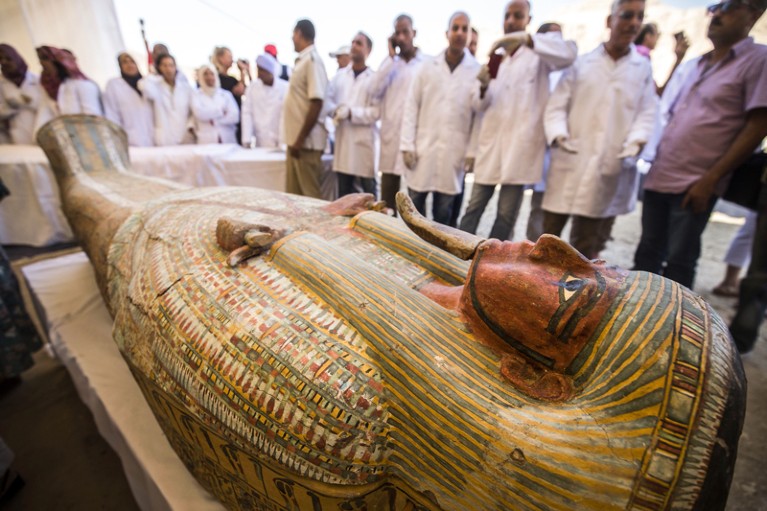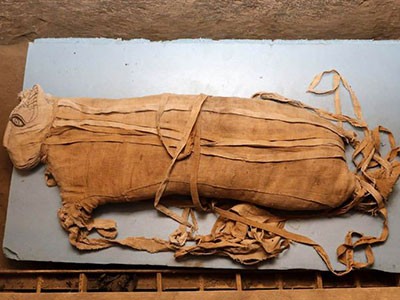
One of the 30 coffins discovered near Luxor last month. For now, Egypt is limiting access to researchers from Egyptian institutions.Credit: Khaled Desouki/AFP/Getty
It’s been a busy few months for Egyptologists. Last week, the discovery of a cache of mummified animals — including the remains of lion cubs — dating back to ancient Egypt’s 26th Dynasty (664–525 bc) was announced at the Saqqara necropolis, south of Cairo.
Last month, officials revealed that 30 sealed coffins and their mummified human contents had been found in the Assasif necropolis near Luxor. These are thought to be linked to the Amun priesthood, one of ancient Egypt’s centres of power, which dates back to the tenth century bc. Further discoveries made in the country will be announced next month, according to Egypt’s antiquities minister, Khaled El-Enany.
Researchers attending the annual congress of the International Association of Egyptologists in Giza earlier this month told Nature of their excitement about the discoveries. But some also expressed disappointment that Egypt’s government will be restricting access — at least for now — to researchers at Egyptian institutions. There will be no open calls for research proposals of the type that museums and funding agencies typically publish to attract the best ideas and expertise.
The government has justifiable reasons for being careful about permitting further international involvement in its heritage. During colonial times, some of Egypt’s most precious artefacts were taken, and many have wound up in Europe’s leading museums.
Rare mummified lions add to Egyptology buzz
The last time that coffins and mummies were discovered on a large scale was in 1891, at Bab el-Gasus (‘the door of the priests’), not far from Luxor. Some of the surviving coffins from that find are now at the Rijksmuseum van Oudheden in Leiden in the Netherlands, and at the Vatican. Moreover, Zahi Hawass, Egypt’s former antiquities minister, has long called for the return of the Rosetta Stone, which has been at the British Museum in London for more than 200 years.
But today’s Egyptology bears little relation to the field’s earlier era. Egypt hosts hundreds of teams of archaeologists from museums and universities around the world who are working in partnership with Egypt’s universities and government. At last month’s congress for Egyptologists, both Hawass and El-Enany were among the main speakers.
There are also many models for research collaboration. Egypt could, for example, issue calls for proposals in which international researchers are invited to join Egypt-led research consortia as co-investigators.
Every nation is the custodian of its heritage — a right that must never again be taken away. But at the same time, Egypt’s rich history, which encompasses many civilizations, is also an example of how science and scholarship flourish when there are few barriers to talent. That is why, when Egypt feels the time is right, its government should consider inviting more of the world’s researchers to work with its own, allowing them to contribute to the latest finds from the country’s fascinating past.

 Rare mummified lions add to Egyptology buzz
Rare mummified lions add to Egyptology buzz
 Adventures of a space archaeologist
Adventures of a space archaeologist
 The wonder of the pyramids
The wonder of the pyramids
 Gigantic Nile dam prompts clash between Egypt and Ethiopia
Gigantic Nile dam prompts clash between Egypt and Ethiopia







